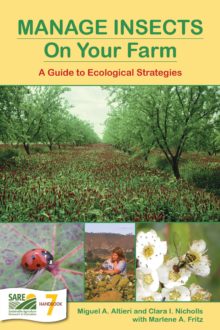Implications for Fertilizer Practices
Conventional synthetic fertilizers can dramatically affect the balance of nutritional elements in plants. When farmers use them excessively, these fertilizers likely create nutritional imbalances with their large pulses of available nitrogen, which in turn compromise crops’ resistance to insect pests.
In contrast, most organic farming practices lead to increased organic matter and microbial activity in soils and the gradual release of plant nutrients; in theory, this should provide more balanced nutrition to plants. While the amount of nitrogen that is immediately available to the crop may be lower when farmers use organic inputs, their crops’ overall nutritional status appears to improve. By releasing nitrogen slowly, over the course of several years, organic sources may help render plants less attractive to pests. Organic soil fertility practices also can supply secondary and trace elements, such as boron, zinc, manganese and sulfur, which are occasionally lacking in conventional farming systems that rely primarily on synthetic sources of nitrogen, phosphorus and potassium.
If, indeed, biochemical or mineral-nutrient differences in organically grown crops enhance resistance, this may explain — at least in part — why lower pest levels have been reported in organic farming systems. Observations of these lower levels support the view that long-term management of soil organic matter leads to better plant resistance to insect pests.
At the USDA Beltsville Agricultural Research Center, researchers discovered a molecular basis for delayed leaf senescence and tolerance to diseases in tomato plants grown in a hairy vetch mulch, compared to the same crop grown on black plastic. The finding is an important step toward a scientific rationale for alternative soil management practices.
Probably due to regulated release of carbon and nitrogen metabolites from hairy vetch decomposition, the cover-cropped tomato plants showed a distinct expression of selected genes, which would lead to a more efficient utilization and mobilization of C and N, promote defense against disease, and enhance crop longevity. These results confirm that in intensive conventional tomato production, the use of legume cover crops offers advantages as a biological alternative to commercial fertilizer, in addition to minimizing soil erosion and loss of nutrients, enhancing water infiltration, reducing runoff, and creating a “natural” pest-predator relationship.
Traditionally considered in isolation from one another, aboveground and belowground components of ecosystems are now thought to be closely linked. The (crop) plant seems to function as an integrator of the above ground and below ground components of agroecosystems. This holistic approach is enhancing our understanding of the role of biodiversity at a global level. In agriculture, such close ecological linkages between above-ground and below-ground biota constitute a key concept on which a truly innovative ecologically based pest management strategy can be built.
